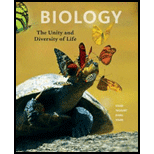
The end product of cleavage is a __________.
- a. gamete
- b. blastula
- c. gastrula
- d. zygote
Concept Introduction: Cleavage is a process of repeated mitotic divisions where the enormous amount of cytoplasm is distributed to form several small cells. Cleavage is a part of development.
Answer to Problem 1SQ
Correct answer: The end product of cleavage is a blastula. Therefore, option b. is correct.
Explanation of Solution
Reasons for the correct statement:
The sperm and egg unite to form the zygote. The zygote then undergoes several mitotic divisions repeatedly. These repeated mitotic divisions are collectively called as cleavage. At the end of cleavage the blastula is formed. The blastula has a covering called as blastoderm and the cavity inside called as blastocoel. The blastula is made of cells called as blastomeres. The size of the blastula varies from species to species.
Option b. is given as “blastula”
As blastula is formed at the end of all cleavage divisions, option b. is correct.
Reasons for the incorrect statements:
Option a. is given as “gamete”. The gamete is produced at the end of gametogenesis not cleavage. Therefore, option a. is incorrect.
Option c. is given as “gastrula”. At the end of cleavage, the blastula is formed first and then the gastrula is formed.
Therefore, option c. is incorrect.
Option d. is given as “zygote”. The zygote undergoes cleavage to form the blastula.
Therefore, option d. is incorrect.
Hence, options a., c., and d. are incorrect.
The end product of cleavage is a blastula. The cleavage is of various patterns based on which the development of the animal is determined.
Want to see more full solutions like this?
Chapter 42 Solutions
Biology: The Unity and Diversity of Life (MindTap Course List)
Additional Science Textbook Solutions
Biological Science (6th Edition)
Laboratory Manual For Human Anatomy & Physiology
General, Organic, and Biological Chemistry - 4th edition
SEELEY'S ANATOMY+PHYSIOLOGY
Biology: Life on Earth with Physiology (11th Edition)
- You inject morpholino oligonucleotides that inhibit the translation of follistatin, chordin, and noggin (FCN) at the 1 cell stage of a frog embryo. What is the effect on neurulation in the resulting embryo? Propose an experiment that would rescue an embryo injected with FCN morpholinos.arrow_forwardParticipants will be asked to create a meme regarding a topic relevant to the department of Geography, Geomatics, and Environmental Studies. Prompt: Using an online art style of your choice, please make a meme related to the study of Geography, Environment, or Geomatics.arrow_forwardPlekhg5 functions in bottle cell formation, and Shroom3 functions in neural plate closure, yet the phenotype of injecting mRNA of each into the animal pole of a fertilized egg is very similar. What is the phenotype, and why is the phenotype so similar? Is the phenotype going to be that there is a disruption of the formation of the neural tube for both of these because bottle cell formation is necessary for the neural plate to fold in forming the neural tube and Shroom3 is further needed to close the neural plate? So since both Plekhg5 and Shroom3 are used in forming the neural tube, injecting the mRNA will just lead to neural tube deformity?arrow_forward
- Can I get this answered with the colors and what type of connection was formed? Hydrophobic, ionic, or hydrogen.arrow_forwardCan I please get this answered with the colors and how the R group is suppose to be set up. Thanksarrow_forwardfa How many different gametes, f₂ phenotypes and f₂ genotypes can potentially be produced from individuals of the following genotypes? 1) AaBb i) AaBB 11) AABSC- AA Bb Cc Dd EE Cal bsm nortubaarrow_forward
- C MasteringHealth MasteringNu × session.healthandnutrition-mastering.pearson.com/myct/itemView?assignment ProblemID=17396416&attemptNo=1&offset=prevarrow_forward10. Your instructor will give you 2 amino acids during the activity session (video 2-7. A. First color all the polar and non-polar covalent bonds in the R groups of your 2 amino acids using the same colors as in #7. Do not color the bonds in the backbone of each amino acid. B. Next, color where all the hydrogen bonds, hydrophobic interactions and ionic bonds could occur in the R group of each amino acid. Use the same colors as in #7. Do not color the bonds in the backbone of each amino acid. C. Position the two amino acids on the page below in an orientation where the two R groups could bond together. Once you are satisfied, staple or tape the amino acids in place and label the bond that you formed between the two R groups. - Polar covalent Bond - Red - Non polar Covalent boND- yellow - Ionic BonD - PINK Hydrogen Bonn - Purple Hydrophobic interaction-green O=C-N H I. H HO H =O CH2 C-C-N HICK H HO H CH2 OH H₂N C = Oarrow_forwardFind the dental formula and enter it in the following format: I3/3 C1/1 P4/4 M2/3 = 42 (this is not the correct number, just the correct format) Please be aware: the upper jaw is intact (all teeth are present). The bottom jaw/mandible is not intact. The front teeth should include 6 total rectangular teeth (3 on each side) and 2 total large triangular teeth (1 on each side).arrow_forwardarrow_back_iosSEE MORE QUESTIONSarrow_forward_ios

 Biology (MindTap Course List)BiologyISBN:9781337392938Author:Eldra Solomon, Charles Martin, Diana W. Martin, Linda R. BergPublisher:Cengage Learning
Biology (MindTap Course List)BiologyISBN:9781337392938Author:Eldra Solomon, Charles Martin, Diana W. Martin, Linda R. BergPublisher:Cengage Learning Concepts of BiologyBiologyISBN:9781938168116Author:Samantha Fowler, Rebecca Roush, James WisePublisher:OpenStax College
Concepts of BiologyBiologyISBN:9781938168116Author:Samantha Fowler, Rebecca Roush, James WisePublisher:OpenStax College Biology: The Unity and Diversity of Life (MindTap...BiologyISBN:9781337408332Author:Cecie Starr, Ralph Taggart, Christine Evers, Lisa StarrPublisher:Cengage Learning
Biology: The Unity and Diversity of Life (MindTap...BiologyISBN:9781337408332Author:Cecie Starr, Ralph Taggart, Christine Evers, Lisa StarrPublisher:Cengage Learning





